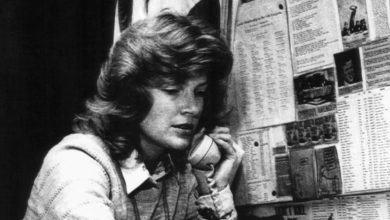‘I’m in Hot Demand, Baby’: Nebraska Thrives (and Copes) With Low Unemployment

Harry’s Wonder Bar is a trusted old dive in Nebraska’s capital, frequented by office clerks, construction workers and graduate students alike: the sort of wood-paneled place with a pool table in the back where phones generally stay in pockets, second fiddle to casual conversation, and beer mugs come frosted regardless of the season.
As a half-dozen or so happy hour patrons gathered at the bar on a recent afternoon, most had something remarkable in common: Everybody seemed to know somebody who had earned a significant raise, or multiple raises, in the past year — and many, if not all, had received a jump in pay themselves.
That included the bartender on the early-evening shift, Nikki Paulk, an easygoing woman with a flash of pink hair. “I’m in hot demand, baby,” she said, mentioning “desperate” employers with a burst of a grin. “I’ve worked at like six bars in the last six months because I just keep getting better offers I can’t turn down.”
The unemployment rate in Nebraska was 2.1 percent in February, tied with Utah for the lowest in the nation and near the lowest on record for any state. In several counties, unemployment is below 1 percent. Even taking into account adults who have left the work force, the share of the population 16 and older employed in Nebraska is around 68 percent, the nation’s highest figure.
After decades of wage and income stagnation, the seesaw of power between managers and their workers looks to at least temporarily be tilting in the direction of labor, with employers in competition for workers instead of the other way around. Unemployment in states including Indiana, Kansas, Montana and Oklahoma is almost as low as in Nebraska, testing the benefits and potential costs of an economy with exceptionally tight labor markets.
Ms. Paulk, 35, graduated from college with a graphic design degree during the Great Recession, when jobs were scarce. She remembers working 60-hour weeks near minimum wage in Illinois, “being excited to find a quarter” that could go toward laundry. In 2013, she moved to Nebraska and took a job in medical data entry for $12 an hour.
She started bartending in 2018, and since then, she says, her overall pay has more than doubled to $25 (and sometimes $30) an hour, including tips.
The nationwide jobless rate in February was 3.8 percent, nearly back to prepandemic levels that were the lowest in a half-century. The particularly low unemployment in Nebraska is partly attributable to its higher-than-average high school graduation rate, and the dominant role of industries like manufacturing and agriculture that are less volatile than the service or energy sectors during downturns. Even at the peak of Covid-19 lockdowns in the spring of 2020, the state unemployment rate was 7.4 percent, half the national number.
Yet the labor market in Nebraska may also be a harbinger for the country at large. Most economists expect overall unemployment to continue ticking downward this year. Job openings are near record highs, and jobless rates in January were lower than a year earlier in 388 of the 389 metropolitan areas evaluated by the Bureau of Labor Statistics.
Many business analysts contend that if labor remains scarce, wages will grow too rapidly and employers will continually pass on that increased expense to consumers. At least for now, evidence of such a spiral is sparse: Federal Reserve data shows that median annual pay increases are well within the range — 3 to 7 percent — that prevailed from the 1980s until the 2007-9 recession.
The Fed, still concerned, has begun raising interest rates to cool off the economy and tame inflationary pressures. Supply chain challenges that arose during the pandemic have persisted, and the war in Ukraine is further complicating the outlook for inflation as well as overall economic growth. Consumer spending remains buoyant, yet surveys reflect dour economic sentiment among the public.
In the meantime, even as price increases nag household budgets, burying the value of some new wage gains, a noticeable mass of employees and job seekers are gaining more leverage regarding benefits and conditions.

Tony Goins was appointed by Gov. Pete Ricketts in 2019 as director of Nebraska’s Department of Economic Development.Credit…Terry Ratzlaff for The New York Times
During a virtual summit about the local economy held in February by the nonprofit group Leadership Lincoln, Eric Thompson, the director of the Bureau of Business Research at the University of Nebraska-Lincoln, argued that the labor market might be simply rebalancing.
“Obviously, it’s still always better to be the employer than the worker, or at least usually it is,” he said. But the current environment does enable some employees to switch jobs or more easily vie for higher-level positions. Local employers are dropping degree requirements for a range of midlevel and entry roles.
Many fast-food restaurants, struggling to staff locations near the $9 minimum wage in the state, have begun to offer starting wages of $14. Evidence of automation is just as rampant as Help Wanted signs: Some pharmacies dotting the main roads and highways appear to have more self-checkout kiosks than employees at a given hour.
Mr. Thompson said such moves were not necessarily ominous for the working class but rather a reflection of the need for businesses to adapt while workers find jobs that can “maximize their skills and potential.”
Tony Goins, a former senior vice president at JPMorgan Chase who was appointed by Gov. Pete Ricketts in 2019 as director of Nebraska’s Department of Economic Development, said the tight labor market could prompt managers to become more flexible and innovative.
“At the end of the day, the market is dictating that I have to pay employees more money,” said Mr. Goins, a small-business owner himself with a cigar lounge in Lincoln. “So, I mean, how are you going to offset that?” To stay competitive in hiring, he said, managers need to improve culture, leadership, employee retention and recruiting.
He spoke of his son, an assistant men’s basketball coach at Boston College — a position that he says requires continued outreach as well as the dual promise of “the chance to play for a winning program” and gaining personal development. “That’s not what C.E.O.s are used to,” he said.
Businesses aiming to grow have begun to offer incentives beyond pay. The Japanese company Kawasaki Motors is spending $200 million to expand the 2.4-million-square-foot site in northern Lincoln where it makes Jet Skis, all-terrain vehicles and rail cars. It is increasing its 2,400-member work force by over 500 employees, with jobs primarily in fabrication, welding and assembly.
The company is becoming more flexible about hiring and work styles in order to pull it off. “It used to take a couple of weeks to get hired at Kawasaki,” said Bryan Seck, its chief talent management strategist in Lincoln. “Now, it’s down to four hours.”
With the knowledge that many parents remain on the sidelines of the work force because of child care duties, Kawasaki recently created a 9 a.m. to 2 p.m. shift tailored for those who need to retrieve children from school and day care in the early afternoon. Starting wages are $18.10 an hour, Mr. Seck said, with benefits including health care and a 401(k) plan.
In addition to increasing wages to retain employees, Todd Heyne, the chief construction officer at Allo Communications, a cable company based in Lincoln, said management decided that easing in-person work requirements could expand the pool of available workers. That led the company to allow many of its customer service representatives and technical support employees to train and work farther afield as it prepares to expand beyond Nebraska and Colorado.
Not all problem-solving is easy. The added labor costs come on top of supply chain pressures that have increased the price of crucial materials like fiber optic cable by as much as 30 percent. Vendors are often charging 20 percent more for their contracted tasks. As a result, the company has taken steps like hiring its own trucking staff.
In the end, “combined with some automation efficiencies, our team will see sizable wage increases with less rudimentary work,” Mr. Heyne said, reducing manual paperwork, centralizing back-end systems and doing more to fix customers’ network issues remotely. So despite the cost challenges, “I’ve never been more optimistic about where we’re sitting, our position in the market, how we compete against our competitors, and our technology,” he added. “Which is strange.”
For many, the opportunity of this economic moment is tinged with worry. They include Ashlee Bridger, a 30-year-old student at the Lincoln campus of Southeast Community College who works in administration for the nearby firm Huffman Engineering after being recruited from a job fair.
Ms. Bridger left her job as a nurse to pursue a career in human resources because she felt confident enough to bet on herself: “Of course, it was a risk. Leaving any career is.” But in the current job market, she said, “I knew I would be able to work my way up easier.”
She has also had a series of life milestones fall into place. She will graduate in May with an associate degree and will start bachelor’s degree work in the fall at Nebraska Wesleyan University. The managers at Huffman have told her that she is welcome to continue working there when her schedule allows, and that they would like to hire her in a more senior role after she completes her studies.
Last year, she got married in summer, then moved with her husband into a newly built house in Lincoln in August. Though they feel financially stable, she half-joked that they were lucky the home was mostly built before lumber prices soared. With prices up across the board now, “I’m more cautious about my spending,” she said.
Ms. Paulk, the bartender at Harry’s thriving off better pay, has friends and customers who are upset about recent inflation. “But it’s something controlled out of our hands anyway,” she said with a shrug.
“All I know,” she added, “is now I’m not broke anymore — it’s great. Life is good.”





